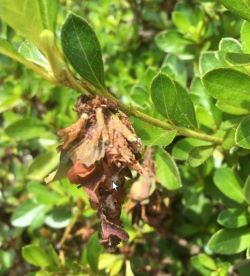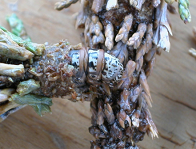Bagworms in Arkansas
What are bagworms?
Bagworms are caterpillars that molt into moths. They are typically identified by the bags they construct as they feed. Bagworm larvae enclose themselves in cone-shaped bags and partially emerge to consume foliage.

This insect is seldom seen, except for the head of the larva protruding from the bag. Larvae are mottled brown to black and enclose themselves in bags spun from silk strands. Bits of leaves and twigs from the host plant are incorporated into the bag during its creation as camouflage. During June, bags are difficult to see, since these newly formed bags are less than 1/4" in length. Bags increase to 1 1/2" in length by late summer.
How serious is a bagworm infestation?
They are a serious pest, capable of rapid buildup and extensive defoliation. Annual surveys during fall, winter, or early spring are important to detect infested plants before serious damage results.
Commonly infested plants
Plants attacked by bagworms include evergreens such as juniper, arborvitae, cedars, cypress, pine, hemlock, and spruce. Broadleaved plants that may be attacked include apple, basswood, black locust, boxelder, elm, honey locust, Indian hawthorn, maple, various oaks, persimmon, sumac, sycamore, wild cherry, willow and azalea.
Signs of bagworm infestation


Infested plants suffer an increasing degree of leaf damage/defoliation from June to late July and August. Stripping of leaves is usually most noticeable in the uppermost parts of trees and shrubbery. Also associated with an infestation of bagworms is the presence of many spindle-shaped bags up to 1 1/2" in length from late summer to spring.
Not sure if you have bagworms? Ask our pest crew.
How to treat for bagworms
Handpicking bagworms off the plants is the cheapest way to control them. Picking off and burning or destroying bags from fall until spring will reduce populations, but it's tedious.
The presence of bags during winter is a good indication of which plants need to be treated the following year. There is only one generation per year. Eggs in bags thrown on the ground will hatch in the spring and develop into larvae that could reinfest the plants.
Chemical control is not as effective when the caterpillars close their bags to molt or pupate. In most areas, insecticides applied in April, May and June are effective. Small larvae are more susceptible to insecticides. Larger larvae and molting larvae are not easily killed. Insecticides with some residual are preferred.
Recommended insecticides for bagworms
Recommended insecticides for homeowners include
- Bacillus thuringiensis kurstaki (Bonide Thuricide, Ferti-Lome Dipel Dust)
- bifenthrin (Ferti-lome Broad Spectrum Insecticide, Hi-Yield Bug Blaster Bifenthrin, Ortho MAX Pro)
- bifenthrin + zeta-cypermethrin (Ortho Home Defense Insect Killer for Lawn & Landscape)
- carbaryl (Bonide Complete Fruit Tree Spray, GardenTech Sevin Concentrate Bug Killer)
- beta cyfluthrin + imidacloprid (Bayer Advanced Dual Action Rose & Flower Insect Killer Ready-To-Use)
- cyfluthrin (Bayer Advanced Vegetable & Garden Insect Spray Concentrate)
- malathion (various)
- spinosad (Bonide Captain-Jacks Deadbug Concentrate, Monterey Garden Insect Spray, Natural Guard Brand By Ferti-lome Spinosad Bagworm, Tent Caterpillar and Chewing Insect Control)
*All chemical information provided is given with the understanding that no endorsement of named products is intended, nor is criticism implied of similar products that are not mentioned. Individuals who use pesticides are responsible for ensuring that the intended use complies with current regulations and conforms to the product label. Before purchasing or using any pesticide, always read and carefully follow the label directions.
More Resources
For more information contact your local county agent.